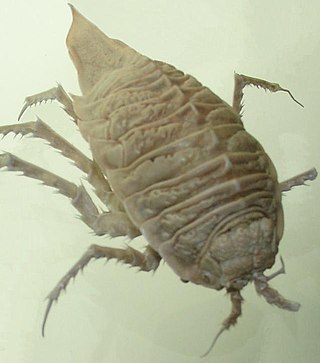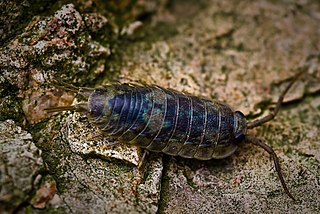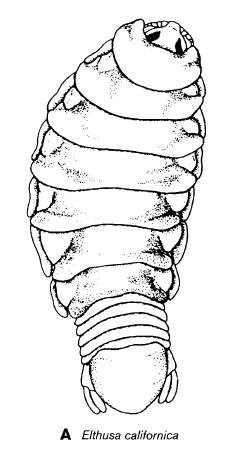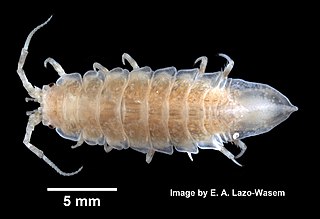
Isopoda is an order of crustaceans. Members of this group are called isopods and include both aquatic species, and terrestrial species such as woodlice. All have rigid, segmented exoskeletons, two pairs of antennae, seven pairs of jointed limbs on the thorax, and five pairs of branching appendages on the abdomen that are used in respiration. Females brood their young in a pouch under their thorax called the marsupium.

Armadillidium vulgare, the common pill-bug, potato bug, common pill woodlouse, roly-poly, slater, doodle bug, or carpenter, is a widespread European species of woodlouse. It is the most extensively investigated terrestrial isopod species. It is native to Mediterranean Europe, but as an introduced species they have become naturalized in almost all suitable ecosystems. They are kept as pets by hobbyists for their wide range of possible color variations.

Cymothoa exigua, or the tongue-eating louse, is a parasitic isopod of the family Cymothoidae. It enters a fish through the gills. The female attaches to the tongue, while the male attaches to the gill arches beneath and behind the female. Females are 8–29 mm (0.3–1.1 in) long and 4–14 mm (0.16–0.55 in) wide. Males are about 7.5–15 mm (0.3–0.6 in) long and 3–7 mm (0.12–0.28 in) wide. The parasite severs the blood vessels in the fish's tongue, causing the tongue to fall off. It then attaches itself to the remaining stub of tongue and the parasite itself effectively serves as the fish's new "tongue".

The Valvifera are marine isopod crustaceans. Valviferans are distinguished, however, by the flat, valve-like uropods which hinge laterally and fold inward beneath the rear part of their bodies, covering the pleopods. Some species are omnivorous, and serve as effective scavengers in the economy of the sea.

Pentidotea wosnesenskii is a marine isopod which lives on seaweed on rocky shores along the British Columbia and Washington coastlines, as far south as San Francisco. It can often be found hiding under rockweed in the intertidal zone, and can be found in depths up to 919 metres (3,015 ft). It was described as Idotea wosnesenskii in 1851, by Johann Friedrich von Brandt, and is named after the Russian biologist Ilya G. Voznesensky. The isopod grows up to 4 centimetres (1.6 in) in length and is usually green in colour.

A giant isopod is any of the almost 20 species of large isopods in the genus Bathynomus. They are abundant in the cold, deep waters of the Atlantic, Pacific, and Indian Oceans. Bathynomus giganteus, the species upon which the generitype is based, is often considered the largest isopod in the world, though other comparably poorly known species of Bathynomus may reach a similar size. The giant isopods are noted for their resemblance to the much smaller common woodlouse, to which they are related.

Idotea is a genus of isopod crustaceans, mostly from cold temperate waters. The taxonomy of the genus is still in doubt, and many of the currently recognised species may be taxonomic synonyms, and others may be moved to different genera.

Idoteidae is a family of aquatic isopods.

Ligia is a genus of isopods, commonly known as rock lice or sea slaters. Most Ligia species live in tidal zone cliffs and rocky beaches, but there are several fully terrestrial species which occur in high-humidity environments.

Sebastes atrovirens, the kelp rockfish, is a species of marine ray-finned fish belonging to the subfamily Sebastinae, the rockfishes, part of the family Scorpaenidae. It is native to the Pacific Ocean along the coast of California in the United States and Baja California in Mexico.
Alloniscus perconvexus is a species of woodlouse in the family Alloniscidae. It is found in North America.
Sphaeroma papillae is a species of isopod in the family Sphaeromatidae known from and potentially endemic to southern New England. It was described from Cold Spring Harbor on Long Island in 1938 and has since then been found in other locations on the north shores of Long Island and Cape Cod. It can be told from the similar Sphaeroma quadridentatum by the presence of two tubercles on the telson and the unserrated outer margin of the outer uropod branch. This species tends to be found in places of the intertidal zone where there is a direct influence with fresh water, such as seeps and pond outlets.

Elthusa californica is a species of isopod in the family Cymothoidae of the order Isopoda. E.californica is a saltwater parasitic isopod. Like many species of the Elthusa genus, E. californica was first placed in within the Liveneca genus, but later underwent taxonomic revisions.

Cubaris murina, commonly known as the little sea isopod or little sea roly poly, is a species of woodlouse in the family Armadillidae. It is found in North America, Africa, South America, Australasia, tropical Asia, and the Pacific Ocean.

Pentidotea is a genus of isopods in the family Idoteidae. There are about 13 described species in Pentidotea.

Idotea metallica, also known as the metallic isopod, is a species of isopod in the family Idoteidae. It can be recognised by its metallic blue colouration and by the blunt, squared-off shape of the telson. It is found worldwide drifting on debris on high seas. It often gets blown inshore, where it is outcompeted by related species such as Idotea balthica.

Idotea phosphorea is a species of isopod in the family Idoteidae. It is found in North America.

Pentidotea aculeata is a species of isopod in the family Idoteidae. It lives in the intertidal region along the coast of California.

Euidotea is a genus of marine isopods belonging to the family Idoteidae. The species of this genus are found in Australia and New Zealand.
Pentidotea kirchanskii is species of isopod in the family Idoteidae. It was first described by Miller & Lee in 1970.

















